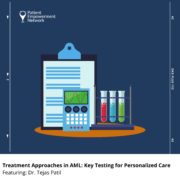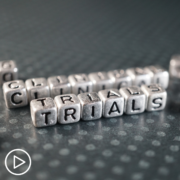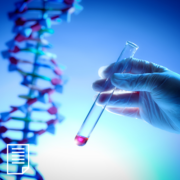New AML Therapies vs Traditional Chemotherapy: What’s the Difference?
New AML Therapies vs Traditional Chemotherapy: What’s the Difference? from Patient Empowerment Network on Vimeo.
Does a newer therapy mean it’s more effective? Dr. Naval Daver, an AML specialist, discusses the differences between newer targeted therapies and chemotherapy, sharing key learnings from recent research.
Dr. Naval Daver is an Associate Professor in the Department of Leukemia at The University of Texas MD Anderson Cancer Center. More about Dr. Daver here.
Related Resources:

|

|

Confused About AML Genetic Testing and Treatment? What You Need to Know |
Transcript:
Katherine:
How do these newer therapies differ from more traditional chemotherapy?
Dr. Daver:
Yeah. Dramatically different. Completely different from traditional chemotherapy. So, to put it in more layman terms, traditional chemotherapy is like a nuclear bomb. Right? You – There’s a lot of things there in the marrow. You don’t know what’s good. You don’t know what’s bad. Blow it all up and hope that, when the new plants grow, the good ones grow and the bad ones were kill. And, in fact, this is true, to a large extent. Traditional chemotherapy, not to put it down, is actually been curative in a large population of AML for the last three decades. Our group and British MRC and Polish, and many groups have published up to 50 to 65 percent cure rates, especially in younger patients, below 65, with traditional chemotherapy.
So, this is not bad. People always get depressed with leukemia. But if you look at solid tumors, I mean, they have never achieved cure rates above 10 to 15 percent till the last decade or so. So, we were still getting 60, 65 percent cure rate. Two out of three.
So, traditional chemotherapy has done great work. But it was that approach. Just nuclear explosion. Take it all out, and hope good stuff comes.
Now the targeted therapy’s like a sniper. It’s actually looking for the particular leukemia cells and trying to take them out one by one with minimum collateral damage to your healthy bone marrow cells, which are important to produce red cells, platelets, white cells. So, guess what? There’s much less toxicity. You don’t see the hair loss with these agents. You don’t see the mouth sores and mucositis. GI complications are much less; infection risk is usually less.
Not to say they don’t have their own side effects. Unfortunately, even the targeted therapies have unique side effects. But, in general, those side effects are much less impactful in a negative quality-of-life way and much more manageable and tolerable. So – And, in the end of the day, they’re actually often more effective.
So, for example, with the FLT3 inhibitor, the study that was done with Gilterinib and Quizartinib, two very potent FLT3 inhibitors, was looking at a single-agent FLT3 inhibitor versus three-drug, high-intensity combination nuclear chemotherapy.
And if I told this to any layperson, they would say, oh my God, that’s completely unfair comparison. You’re going to use three drugs, IV chemo, strong chemo, and compare it to one oral targeted pill. There’s no way the pill can be even equal, leave apart, win.
But guess what? The targeted therapy actually won. It not only was equal. It doubled the response rates, it reduced the toxicities and early mortality and led to improved overall survival, the gold standard. So, this shows that even though they are sniper, they can actually be much more effective with less toxicity. So, it’s a win-win. Better, tolerable, and more effective. Now the next stage within then decade, we think, it’s not one or the either, it’s really a combination. So, we’re reducing the dose of chemotherapy. So, we’re not making it as nuclear as it was. It’s still intense. But much more tolerable. And we’re compensating for that by adding the targeted therapy.
And, in fact, in the end, we expect much higher responses and survival with much better tolerability and lower early mortality. But I don’t think we’re at a stage where traditional chemotherapy is gone. Maybe 10, 12 years from now, as many more developments come, we’ll get there. But I think it still has a role, especially in the younger AML patients.
Katherine:
Dr. Daver, you mentioned the – some common side effects of chemotherapy. What about some of the newer therapies? Do they also have side effects?
Dr. Daver:
Yeah. Absolutely. I mean, every therapy we have in leukemia has a side effect. There’s no drug I can mention that is just devoid of them. Of course, some are less, and some are more. So, to be more specific, I think, for example, IDH1, IDH2 inhibitors, these are probably one of the most tolerable treatments we have in all of leukemia treatment. In general, they don’t cause much myelosuppression. Meaning, drop in blood counts. They don’t cause hair loss. They don’t cause mouth sores and GI upset in majority of people.
They’re always some patients who may. But what they can cause are two things: Number one, is they can cause what we call the differentiation syndrome.
And differentiation syndrome means the blasts that are going from the immature state to the mature state; in that process, they can cause an inflammatory reaction. And this can manifest with fever and cough, and chest pain, hypoxia. It’s something that’s actually very, very easily treatable, giving steroids for three or four days will take care of it. But many times, people were not aware of this. And so, often, we saw this was missed in the community.
So, that’s one specific example. With the FLT3 inhibitors, sometimes we see that they can cause more prolonged drop in blood counts, and count recovery can be delayed. Or we can sometimes see that they may cause some cardiac signals; increase in cardiac intervals. Again, something that, with close monitoring, bloodwork, keeping the electrolytes normal, can be managed. But I don’t want to go through the whole list. But the point is that there are specific and unique side effects that can be seen with particular targeted therapies.
And again, this is a learning curve where we have done these trials for eight to 10 years. So, we became familiar. But when the drug is approved, it’s a – it’s kind of a night-and-day situation in the community. They didn’t have the drug yesterday. They have it today. But there may not be any learning curve there. So, I think that’s where a lot of education and interaction with our colleagues is now coming into play.
But also, patients, I think, need to take this a little bit into their own hands, and also read about the label, read about the drug. So that, if they have side effects, if they actually ask their doctor and say, do you think this could be differentiation? I read about it. Yeah, most people will at least think about it. And I think this could be helpful to make sure that things are not missed. So, we do want patients to be more interactive and kind of take things into their own hands. Because there are so many new drugs out there that their doctors may not be fully familiar yet.










